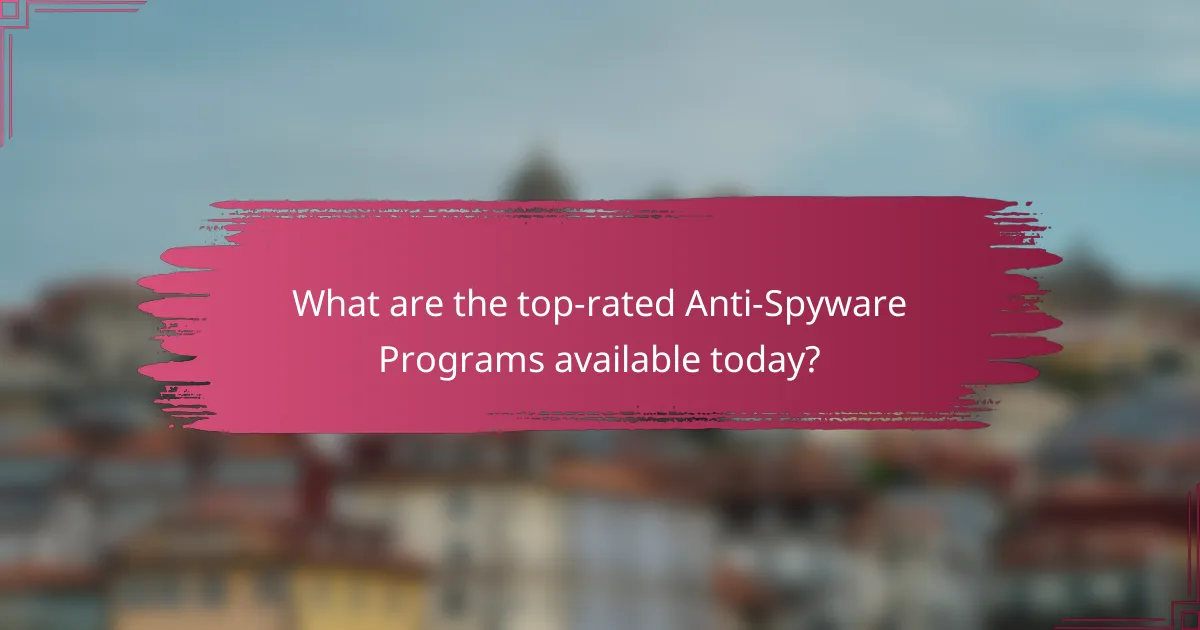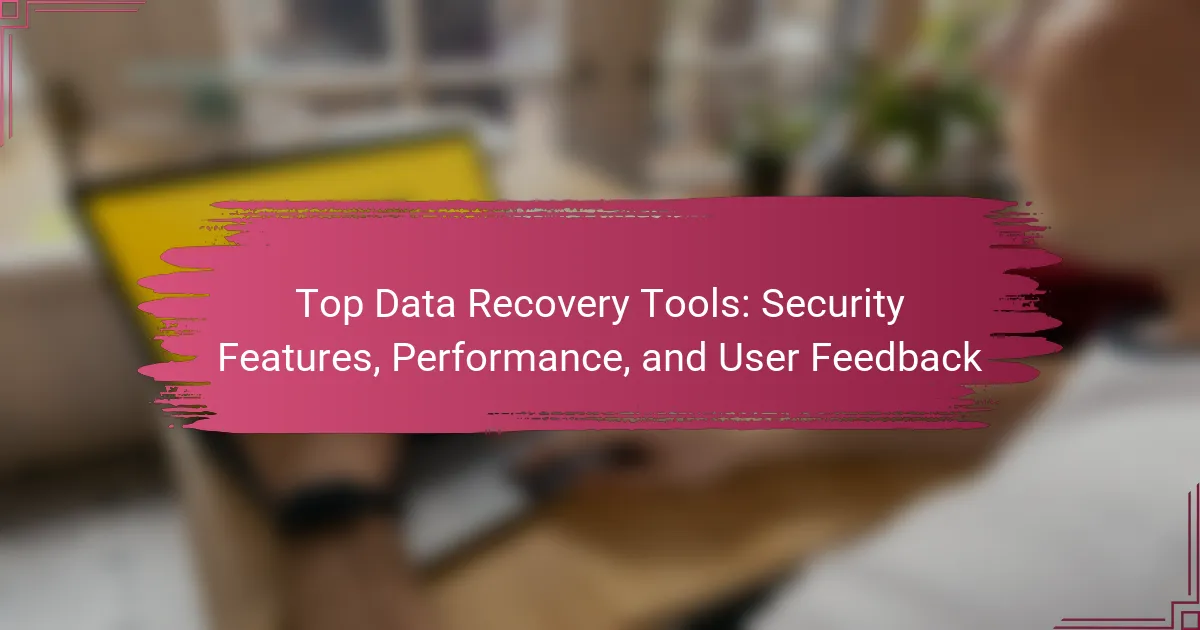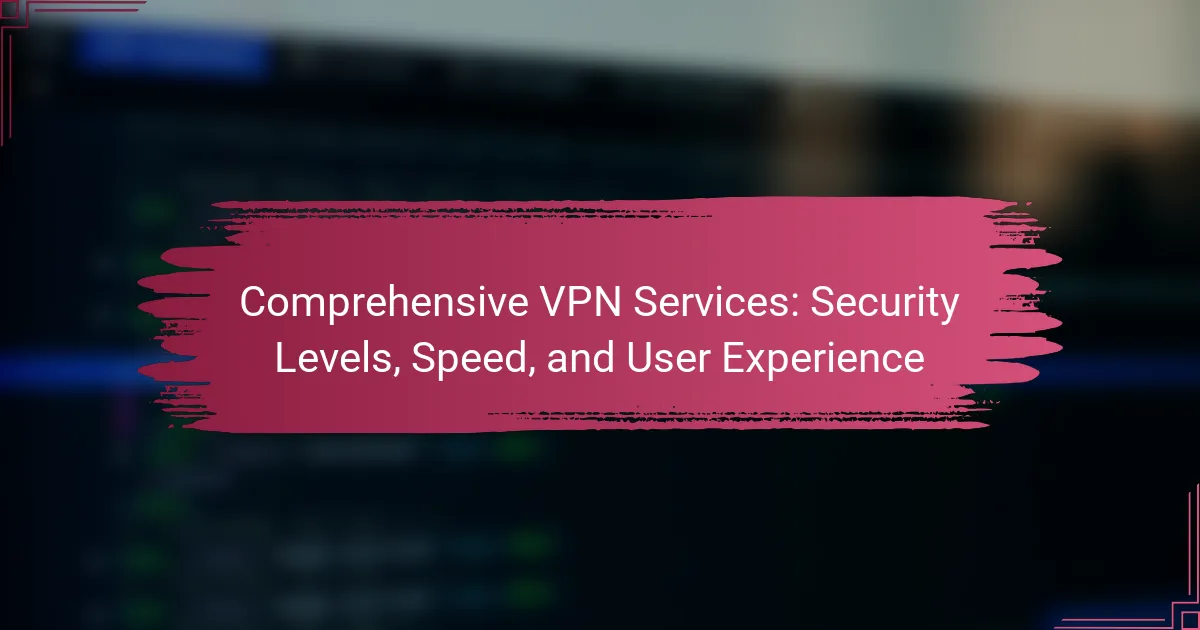Leading anti-spyware programs are software solutions specifically designed to detect and remove spyware from computers and devices. This article focuses on three top-rated programs: Malwarebytes, Spybot Search & Destroy, and Bitdefender Anti-Malware, highlighting their detection rates, features, and user reviews. Malwarebytes is recognized for its high detection rate and real-time protection, achieving a 99.8% detection rate according to AV-Test. Spybot Search & Destroy offers advanced privacy protection features, while Bitdefender Anti-Malware combines effective spyware detection with a user-friendly interface. The article also discusses best practices for users to maximize the effectiveness of their anti-spyware solutions, including regular updates and proactive security measures.

What are Leading Anti-Spyware Programs?
Leading anti-spyware programs are software solutions designed to detect and remove spyware from computers and devices. These programs include well-known names such as Malwarebytes, Spybot Search & Destroy, and Bitdefender Anti-Malware. Malwarebytes offers real-time protection and a high detection rate for various threats. Spybot Search & Destroy provides advanced features for privacy protection and system immunization. Bitdefender Anti-Malware combines spyware detection with comprehensive malware protection. User reviews often highlight their effectiveness and ease of use. According to AV-Test, Malwarebytes achieved a 99.8% detection rate in recent evaluations.
How do Leading Anti-Spyware Programs function?
Leading anti-spyware programs function by scanning, detecting, and removing malicious software designed to spy on users. They utilize signature-based detection to identify known spyware by comparing files against a database of known threats. Heuristic analysis is employed to detect new or unknown spyware by analyzing behavior and characteristics. Real-time protection monitors system activity to prevent spyware installation. Scheduled scans allow users to regularly check for spyware. Additionally, these programs often provide quarantine features to isolate detected threats. Regular updates ensure the database of threats remains current, improving detection rates. According to AV-Comparatives, leading programs can achieve detection rates exceeding 99% for known threats.
What technologies do these programs use for detection?
Anti-spyware programs use various technologies for detection. Common methods include signature-based detection, heuristic analysis, and behavioral monitoring. Signature-based detection relies on a database of known malware signatures. Heuristic analysis evaluates the behavior of programs to identify potential threats. Behavioral monitoring observes real-time actions of applications to detect suspicious activities. These technologies work together to enhance detection rates and improve overall security.
How do detection methods differ among programs?
Detection methods differ among anti-spyware programs primarily in their approach to identifying threats. Some programs utilize signature-based detection, which relies on known malware signatures. Others employ heuristic analysis, examining behaviors and characteristics to detect unknown threats. Behavioral detection monitors system activity in real-time to identify suspicious behavior. Cloud-based detection leverages databases of threats maintained online, allowing for rapid updates and broader coverage. Furthermore, some programs incorporate machine learning algorithms to enhance detection accuracy. Each method has its strengths and weaknesses, impacting overall effectiveness. For instance, signature-based methods may miss new variants, while heuristic methods can generate false positives.
What key features should users look for in Anti-Spyware Programs?
Users should look for real-time protection in anti-spyware programs. This feature actively monitors system activities to detect and block spyware threats as they occur. Another important feature is malware detection and removal capabilities. Effective programs should identify various types of spyware, including adware and trojans.
Regular updates are crucial for maintaining effectiveness against new threats. Programs should automatically update their databases to include the latest spyware signatures. A user-friendly interface enhances usability, making it easier for users to navigate and configure settings.
Additionally, scanning options are vital. Users should have the ability to perform quick scans, full system scans, and custom scans. Compatibility with various operating systems is also important. Anti-spyware programs should function seamlessly across different platforms, such as Windows, macOS, and mobile devices.
Finally, customer support can be a deciding factor. Reliable customer service ensures users can get help when needed. Overall, these features collectively enhance the effectiveness and user experience of anti-spyware programs.
What are the essential protective features?
Essential protective features of leading anti-spyware programs include real-time protection, malware detection, and removal capabilities. Real-time protection continuously scans for threats as they occur, preventing infections before they can cause harm. Malware detection uses advanced algorithms to identify known and unknown spyware. Removal capabilities ensure that detected threats are effectively eliminated from the system. Additional features may include scheduled scans, automatic updates, and user-friendly interfaces. These features collectively enhance a user’s security posture against spyware threats.
How do user interfaces impact the effectiveness of these programs?
User interfaces significantly impact the effectiveness of anti-spyware programs. A user-friendly interface enhances user engagement and reduces the likelihood of errors during operation. Clear navigation allows users to quickly access features, improving overall efficiency. Intuitive design can facilitate better understanding of program functionalities. Studies show that programs with well-designed interfaces report higher user satisfaction rates. For instance, a survey by UserTesting found that 70% of users prefer software with simpler interfaces. Effective user interfaces contribute to higher detection rates by encouraging users to utilize all available features.
Why are detection rates important in choosing an Anti-Spyware Program?
Detection rates are crucial when selecting an anti-spyware program. High detection rates indicate the software’s effectiveness in identifying and removing spyware threats. For instance, a program with a 98% detection rate is more reliable than one with a 70% rate. This reliability reduces the risk of spyware infections, protecting sensitive data and maintaining system performance. According to AV-Test, top-tier anti-spyware programs consistently show high detection rates, often above 95%. Therefore, users should prioritize detection rates to ensure comprehensive protection against evolving spyware threats.
How are detection rates measured?
Detection rates are measured by evaluating the effectiveness of anti-spyware programs in identifying and removing malicious software. This process typically involves testing the software against a database of known spyware samples. The detection rate is calculated as the percentage of spyware samples successfully identified by the software. For instance, if a program detects 90 out of 100 samples, its detection rate is 90%. Independent testing organizations often conduct these evaluations to ensure accuracy. They provide standardized environments and methodologies for consistent results. Reports from organizations like AV-TEST or AV-Comparatives are commonly referenced for these metrics.
What factors influence detection rates?
Detection rates are influenced by several key factors. The quality of the detection algorithms plays a crucial role. Advanced algorithms can identify more threats effectively. The frequency of updates also impacts detection rates. Regular updates ensure the software recognizes the latest threats. The size of the malware database is another important factor. A larger database increases the likelihood of detecting various threats. User behavior can also affect detection rates. Users who practice safe browsing habits may experience fewer detections. Additionally, system performance can influence how quickly threats are identified. Faster systems can process scans more efficiently, leading to higher detection rates.

What are the top-rated Anti-Spyware Programs available today?
The top-rated anti-spyware programs available today include Malwarebytes, Spybot Search & Destroy, and Bitdefender Anti-Malware. Malwarebytes is known for its strong detection rates and real-time protection features. It has consistently received high user ratings for its effectiveness against spyware and malware. Spybot Search & Destroy offers advanced scanning options and immunization features, making it a popular choice among users. Bitdefender Anti-Malware combines robust spyware detection with a user-friendly interface. It ranks highly in independent lab tests for malware detection. These programs are frequently recommended by cybersecurity experts and receive positive user reviews for their performance and reliability.
How do user reviews shape perceptions of Anti-Spyware Programs?
User reviews significantly influence perceptions of anti-spyware programs. They provide firsthand accounts of effectiveness and user experience. Positive reviews often enhance trust and credibility in a program. Conversely, negative reviews can deter potential users. Research shows that 79% of consumers trust online reviews as much as personal recommendations. User feedback highlights specific features and performance metrics. This feedback helps potential users make informed decisions. Overall, user reviews act as a critical factor in shaping market perception of these software solutions.
What common themes emerge in user reviews?
Common themes in user reviews of leading anti-spyware programs include effectiveness, ease of use, customer support, and pricing. Users frequently mention the programs’ ability to detect and remove spyware effectively. Ease of installation and user-friendly interfaces are also commonly highlighted. Many reviews emphasize the importance of responsive customer support for resolving issues. Pricing and value for money are recurring points of discussion, with users assessing whether the features justify the cost. Additionally, users often express concerns about system performance impacts during scans. These themes reflect the critical factors influencing user satisfaction and decision-making in selecting anti-spyware solutions.
How do user experiences differ across various programs?
User experiences differ across various anti-spyware programs based on effectiveness, usability, and support. Some programs excel in detection rates, leading to higher user satisfaction. For example, Malwarebytes is often praised for its user-friendly interface and effective malware removal. In contrast, programs like Norton may have a steeper learning curve but offer comprehensive features. Customer support quality also varies; programs with responsive support teams tend to receive better user reviews. Additionally, the frequency of updates impacts user experience, with more frequent updates generally resulting in improved protection and satisfaction. Overall, these factors contribute to the diverse user experiences across anti-spyware programs.
What are the pros and cons of the leading Anti-Spyware Programs?
Leading anti-spyware programs have various pros and cons. Pros include high detection rates for malware and spyware, which enhance user security. Many programs offer real-time protection, preventing threats before they infiltrate systems. User-friendly interfaces make these programs accessible for all skill levels. Regular updates keep the software effective against new threats. Cons include potential system slowdowns during scans. Some programs may have limited effectiveness against advanced threats. Subscription costs can be a barrier for some users. Additionally, false positives can lead to unnecessary alerts.
What advantages do these programs offer users?
Leading anti-spyware programs offer users enhanced security against malicious software. They provide real-time protection, which detects and blocks threats as they occur. These programs also offer regular updates to stay ahead of evolving spyware. Users benefit from comprehensive scanning features that identify existing threats on their devices. Additionally, many programs include user-friendly interfaces for easy navigation and management. Some solutions offer system optimization tools to improve device performance. According to a study by AV-Test, top anti-spyware programs achieve detection rates exceeding 99%. This high efficiency ensures users’ data remains secure and private.
What limitations should users be aware of?
Users should be aware that anti-spyware programs can have limitations in their detection capabilities. Some programs may not identify all types of spyware, especially new or sophisticated variants. The effectiveness of detection often depends on the program’s database and update frequency. Users may also experience performance slowdowns during scans. Additionally, certain programs may require manual intervention for full system scans. Compatibility issues with other security software can arise, limiting their effectiveness. Lastly, relying solely on one anti-spyware program may leave users vulnerable to threats that others could detect.

How can users maximize the effectiveness of their Anti-Spyware Programs?
Users can maximize the effectiveness of their anti-spyware programs by regularly updating the software. Frequent updates ensure that the program has the latest definitions to detect new threats. Users should also run scheduled scans to consistently check for spyware on their devices. This proactive approach can identify and eliminate potential threats before they cause harm. Additionally, enabling real-time protection can help block spyware attempts as they occur. Users should avoid downloading software from untrusted sources, as this can introduce spyware. Educating themselves about phishing attacks can also prevent inadvertent installations of spyware. Finally, utilizing multiple layers of security, such as firewalls, can enhance overall protection.
What best practices should users follow when using Anti-Spyware Programs?
Users should regularly update their anti-spyware programs to ensure they have the latest protection. Updating software allows users to access new definitions and features. Frequent updates help in defending against the latest threats. Users should perform regular system scans to identify and remove any spyware. Scheduled scans can automate this process for convenience. Users should also enable real-time protection features when available. This feature actively monitors for threats as they arise. Users should avoid downloading software from untrusted sources. This practice minimizes the risk of inadvertently installing spyware. Lastly, users should read reviews and ratings of anti-spyware programs. Researching user experiences can guide informed decisions on software selection.
How often should users update their Anti-Spyware software?
Users should update their Anti-Spyware software at least once a week. Regular updates ensure that the software can detect the latest threats. Cyber threats evolve rapidly, with new spyware emerging daily. Weekly updates help maintain optimal protection. Some software may offer daily updates to provide even better security. Keeping the software updated is crucial for effective defense against malware. According to cybersecurity experts, outdated software is a primary vulnerability. Regular updates significantly reduce the risk of infection and data breaches.
What additional security measures complement Anti-Spyware Programs?
Firewalls complement Anti-Spyware Programs by monitoring incoming and outgoing network traffic. They create a barrier between a trusted internal network and untrusted external networks. Regular software updates enhance security by patching vulnerabilities that could be exploited by spyware. Strong passwords protect user accounts from unauthorized access, reducing the risk of spyware installation. User education on phishing tactics helps individuals recognize and avoid malicious links or attachments. Antivirus software provides an additional layer of protection by detecting and removing various types of malware, including spyware. Together, these measures create a comprehensive security strategy against spyware threats.
What troubleshooting tips can help users resolve common issues with Anti-Spyware Programs?
To resolve common issues with anti-spyware programs, users should follow specific troubleshooting tips. First, ensure the software is up to date. Regular updates help protect against new threats. Second, restart the computer after installation or updates. This can resolve temporary glitches. Third, check the program’s settings. Incorrect settings may prevent effective scanning. Fourth, run a full system scan. This can identify and remove existing threats. Fifth, disable conflicting software. Other security programs can interfere with anti-spyware functionality. Sixth, consult the program’s help resources. Many provide FAQs or user forums for assistance. Lastly, consider reinstalling the software if problems persist. This can fix corrupted files or settings.
How can users address performance issues with their software?
Users can address performance issues with their software by optimizing system resources and updating the software regularly. Reducing the number of background applications can free up memory and CPU usage. Clearing cache and temporary files can also improve performance. Running regular software updates ensures that users benefit from the latest performance enhancements and bug fixes. Additionally, users should consider reinstalling the software if issues persist, as this can resolve corrupted files. Monitoring system performance through task managers can help identify resource-heavy applications. These steps are supported by findings from various tech support resources, indicating that proactive maintenance can significantly enhance software efficiency.
What steps should be taken if a program fails to detect spyware?
If a program fails to detect spyware, first, update the anti-spyware program. Updates often include new definitions and detection capabilities. Next, perform a full system scan to identify any hidden threats. Ensure that the program is configured to scan all files and processes. If detection still fails, consider using a second opinion scanner from a reputable source. Some spyware may evade detection by specific programs. Lastly, seek professional help if the issue persists, as experts can provide advanced tools and techniques for spyware removal.
Leading anti-spyware programs are software solutions designed to detect and eliminate spyware threats from devices. This article covers the top-rated programs, including Malwarebytes, Spybot Search & Destroy, and Bitdefender Anti-Malware, highlighting their detection rates, key features, and user reviews. It explores how these programs function, the technologies they use for detection, and the essential protective features users should consider. Additionally, it discusses the impact of user interfaces on effectiveness, common user experiences, and best practices for maximizing protection against spyware.



